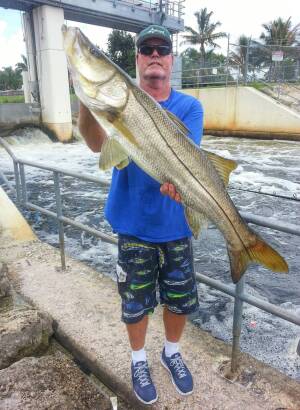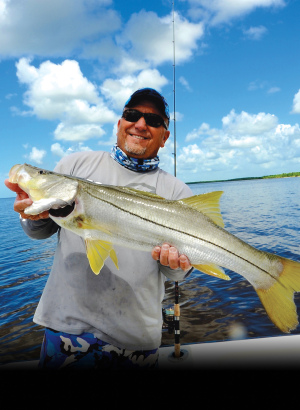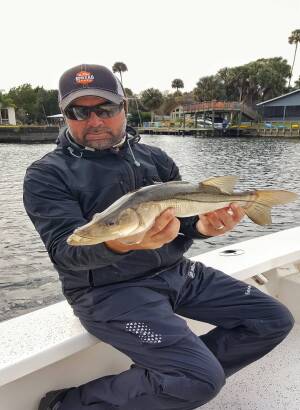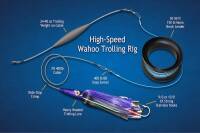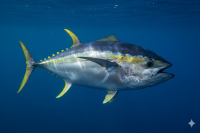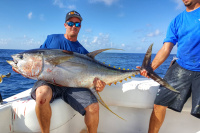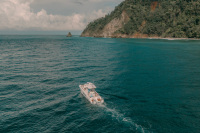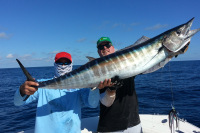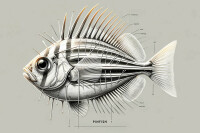Winter snook fishing in Florida challenges anglers because temperature changes completely alter fish behavior and location patterns. Understanding how snook respond to thermal dynamics transforms frustrating cold-weather fishing into predictable success. Learn the science behind thermal refuges, optimal timing windows, and specialized techniques that concentrate snook throughout Florida's winter months.

Florida Inshore Fishing - Winter Snook
Winter Snook Fishing in Florida: Complete Guide to Cold Weather Success
Understanding winter snook fishing in Florida requires recognizing that everything you know about warm-weather snook behavior changes dramatically when temperatures drop. Think of it like watching your favorite athlete perform at peak condition versus watching them compete while wearing a heavy winter coat - the fundamental capabilities remain the same, but the performance characteristics shift completely. This transformation affects where snook position themselves, how they feed, what snook baits they prefer, and how you must adapt your snook fishing gear to maintain consistent success.
Snook fishing Florida waters during winter months presents unique challenges that separate successful anglers from those who struggle through the cooler season. The key lies in understanding that winter snook become concentrated in specific locations rather than scattered throughout their typical summer haunts. This concentration actually works to your advantage once you learn to identify and exploit the thermal refuges where snook gather to maintain their body temperature and energy levels.
Understanding the Science: Why Snook Behavior Changes in Winter
Learning why snook behavior transforms during winter begins with understanding the physiological changes that occur when water temperatures drop below their comfort zone. Snook are tropical fish whose metabolic rate directly correlates with water temperature - imagine your smartphone battery draining slower in cold weather, and you begin to understand how snook conserve energy during winter months.
When water temperatures drop below 60 degrees Fahrenheit, snook experience a dramatic slowdown in their digestive system, feeding frequency, and overall activity level. This metabolic reduction serves as a survival mechanism that allows snook to conserve energy during periods when their preferred prey species also become less active and harder to locate. Understanding this biological imperative helps you predict where snook will be and how they will behave throughout the cooling season.
The metabolic changes create predictable behavioral patterns that successful snook fishing strategies must accommodate:
- Reduced feeding frequency: Snook may feed only once every few days instead of multiple times daily
- Decreased aggression: Strikes become more subtle and deliberate rather than explosive
Habitat concentration: Snook abandon open areas in favor of thermal refuges - Extended digestion periods: Snook require more time to process meals between feeding cycles
How Snook Select Winter Habitat
Snook habitat selection during winter follows predictable patterns based on thermal advantages and energy conservation principles. Think of snook as seeking underwater "warm rooms" where they can maintain optimal body temperature while expending minimal energy. These thermal refuges share common characteristics that you can learn to recognize and systematically locate.
The most productive winter snook locations provide multiple thermal advantages that work together to create optimal conditions:
- Wind protection: Canals, rivers, and creeks oriented north-south provide natural barriers against cold fronts
- Solar absorption: Areas with dark bottom composition and southern exposure maximize heat retention
- Thermal layering: Deep holes and channels where warmer water settles during overnight cooling
- Current breaks: Structure that creates slack water areas where snook can rest without fighting flow
Strategic Location Selection for Winter Snook Fishing Florida
Developing a systematic approach to locating winter snook requires understanding how thermal dynamics create the temperature gradients that snook seek during cold weather periods. The most successful snook fishing Florida anglers learn to think like underwater meteorologists, reading environmental conditions to predict where snook will concentrate as temperatures fluctuate.
Reading Tidal Influence on Snook Location
Tidal movements significantly impact winter snook fishing success because they control the distribution of warmer and cooler water masses throughout coastal systems. Understanding this relationship helps you time your fishing efforts with conditions that favor snook activity rather than working against natural patterns.
Outgoing tides generally provide better winter snook fishing opportunities because they draw warmer water from inland areas toward coastal zones where snook typically concentrate. This warmer water creates temporary thermal advantages that activate snook feeding behavior, even during otherwise challenging conditions. The key lies in positioning yourself in areas where this warmer water flow concentrates snook and their prey species.
Critical tidal timing considerations include:
- Outgoing tide advantages: Draws warmer inland water toward snook holding areas
- Incoming tide challenges: Often brings cooler ocean water that reduces snook activity
- Tide change periods: Snook often feed most actively during the transition between tidal movements
- Spring tide effects: Stronger tidal flows create more pronounced temperature mixing and feeding opportunities
Identifying Thermal Refuges Through Environmental Clues
Successful winter snook location requires developing the ability to read environmental clues that indicate thermal advantages. These visual indicators help you identify potential snook habitat before you even put a line in the water, allowing you to plan more effective fishing strategies.
Residential waterfront areas often provide unique thermal opportunities because human development creates artificial warming factors that benefit winter snook populations. Seawalls absorb solar heat during sunny periods and release it gradually, creating localized temperature increases. Swimming pools, hot tubs, and even air conditioning systems occasionally discharge warmer water that attracts snook to specific areas.
Environmental indicators of thermal advantages include:
- Steam or fog: Visible evidence of water temperatures warmer than surrounding air
- Bird activity: Wading birds often concentrate where warmer water holds baitfish
- Vegetation differences: Aquatic plants may appear greener or more active in warmer areas
- Structure orientation: Docks, seawalls, and bridges that receive maximum sunlight exposure
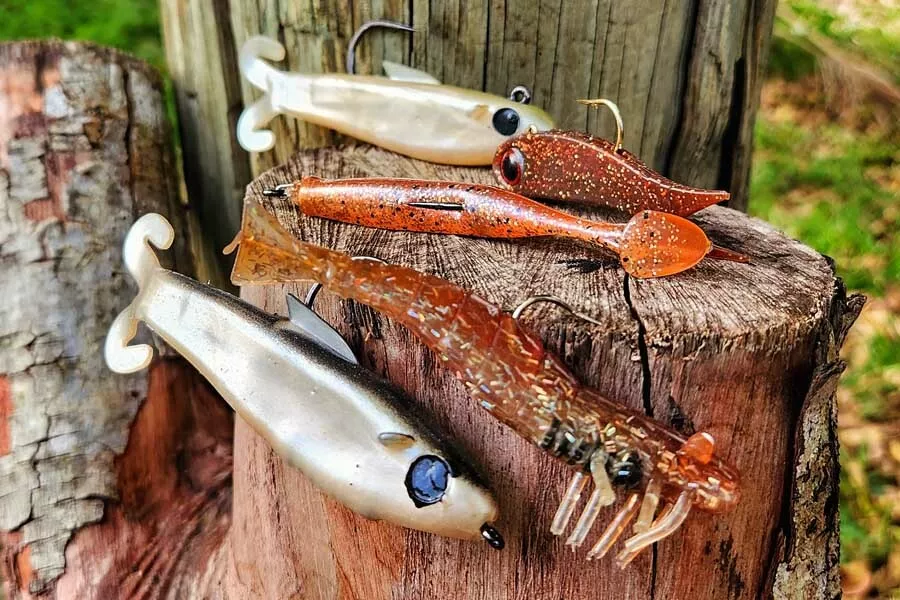
Mastering Snook Baits and Lure Selection for Winter Success
Understanding why certain snook baits excel during winter months requires grasping the fundamental changes in snook feeding behavior when their metabolism slows significantly. The key principle involves matching your bait presentation to the energy-conservation mindset that governs winter snook behavior - they want maximum nutritional return for minimum energy expenditure.
The Science Behind Live Bait Effectiveness
The superiority of live bait for snook during winter stems from multiple factors that align perfectly with cold-weather snook physiology and behavior patterns. Live baits provide continuous scent trails that help snook locate food without expending energy on extensive searching behavior. The natural movement patterns of live baits also require minimal energy for snook to intercept successfully, unlike artificial presentations that might require aggressive pursuit.
Live shrimp represents the premier winter snook bait because it delivers optimal nutritional density while requiring minimal capture energy from lethargic snook. The high protein content provides excellent energy return on the snook's investment, while the natural scent creates attraction that works effectively in the deeper water where winter snook often concentrate.
Key advantages of live shrimp for winter snook fishing:
- Protein density: Provides maximum nutrition per calorie expended during pursuit
- Scent attraction: Creates continuous scent trails that attract snook from greater distances
- Natural movement: Moves in ways that require minimal energy for snook to intercept
- Size flexibility: Available in various sizes to match local conditions and snook preferences
When presenting live shrimp during winter, focus on areas near structure or current breaks where the natural movement attracts snook without requiring active manipulation that might make the presentation appear unnatural.
Strategic Live Baitfish Presentations
Small live baitfish such as pilchards, threadfin herring, and pinfish excel in winter snook fishing applications when you understand the presentation principles that make them effective. The critical factor involves allowing these baits to swim naturally rather than imparting additional movement through rod manipulation or aggressive trolling speeds.
The natural swimming behavior of live baitfish matches the reduced activity levels that snook expect from their prey during colder periods. Slow-trolling or drift fishing with live baitfish covers water efficiently while maintaining the subtle presentation that winter snook consistently prefer over more aggressive artificial alternatives.
Effective live baitfish strategies include:
- Slow presentation speeds: Allow baits to swim naturally without forced movement
- Minimal rod manipulation: Let the bait's natural behavior provide all necessary action
- Strategic positioning: Place baits near thermal refuges where snook concentrate
- Extended soak times: Allow snook adequate time to locate and commit to baits
This patient approach aligns with the deliberate feeding behavior that characterizes winter snook and significantly improves your success rate compared to more aggressive warm-weather techniques.
Artificial Snook Lures for Cold Water Conditions
Selecting snook lures for winter requires completely rethinking your approach toward presentations that can be worked slowly while maintaining realistic action at reduced retrieval speeds. The fundamental principle involves matching the lethargic behavior of natural prey rather than attempting to trigger aggressive feeding responses that rarely occur when snook metabolism slows.
Soft plastic baits for snook represent the most versatile option for winter snook lures because they excel at subtle presentations that can be customized to match specific conditions. These lures allow you to work with minimal movement while still providing enough action to attract attention from nearby snook. The ability to pause presentations frequently lets you match the stop-and-go feeding behavior that characterizes winter snook activity.
Effective snook lures for winter conditions share common characteristics:
- Slow-sink rates: Allow extended time in the strike zone during pauses
- Subtle action: Provide realistic movement without requiring aggressive retrieval
- Natural colors: Match the subdued appearance of winter prey species
- Scent enhancement: Compensate for reduced visual feeding in deeper or murky water
Jerk baits and suspending plugs work effectively when you master the art of extended pauses between twitches. These snook lures should be worked with long delays that allow snook time to locate and approach the bait, with the suspension feature keeping the lure in the strike zone during critical pause periods.
Color Selection Strategy for Winter Snook Lures
Natural color patterns become significantly more important in winter snook lures because the clearer water conditions typical of cooler months make snook more visually discriminating. The reduced feeding aggression means snook have additional time to inspect potential meals, making realistic color schemes essential for consistent success rather than merely helpful.
The most effective winter color choices focus on mimicking the subdued appearance of natural prey species during cold weather periods:
- Silver and white patterns: Match stressed or dying baitfish that snook encounter naturally
- Natural baitfish colors: Realistic representations of pilchards, herring, and other common prey
- Muted tones: Avoid bright or contrasting colors that might spook cautious winter snook
- Translucent options: Soft plastics with realistic transparency that mimics natural baitfish
Essential Snook Fishing Gear and Tackle Systems
Building an effective snook fishing gear system for winter requires understanding how the seasonal changes in snook behavior create specific equipment demands that differ significantly from warm-weather requirements. The challenge involves detecting subtle strikes while maintaining the strength needed to control fish during the prolonged fights typical of cold-weather snook fishing.
Rod Selection: Engineering Sensitivity with Strength
Your rod choice forms the foundation of effective winter snook fishing tackle because it must simultaneously accomplish seemingly contradictory tasks. The rod needs enough sensitivity to detect the light strikes that characterize winter feeding behavior while providing sufficient backbone to control fish during longer, more methodical fights that winter snook typically provide.
Medium-heavy action rods with sensitive tips represent the optimal engineering solution for winter conditions because they address both requirements through strategic design. The medium-heavy rating provides structural strength needed for fighting large snook around structure, while the sensitive tip section allows detection of subtle mouth movements and light takes that might otherwise go unnoticed.
Critical rod specifications for winter snook fishing gear:
- Length range: 7 to 7.5 feet provides casting distance while maintaining strike detection sensitivity
- Action type: Medium-heavy with fast or extra-fast tip for optimal sensitivity
- Construction material: High-modulus graphite offers the best strength-to-sensitivity ratio
- Guide quality: Premium guides reduce friction and improve overall system sensitivity
Reel Engineering for Winter Snook Fishing
Spinning reels in the 3000 to 4000 size range provide the ideal balance of line capacity, drag performance, and retrieval characteristics specifically needed for winter snook fishing reel systems. However, understanding why these specifications matter helps you select equipment that enhances rather than limits your winter fishing effectiveness.
Gear ratio selection becomes more critical during winter because the presentation techniques that work best for lethargic snook require slower, more controlled retrieval speeds. Lower gear ratios favor torque over speed, allowing you to maintain consistent lure action even at the reduced speeds that winter snook consistently prefer.
Essential reel characteristics for winter snook fishing gear:
- Size classification: 3000-4000 series provides line capacity without excessive weight
- Gear ratio range: 5.0:1 to 5.5:1 delivers torque needed for slow, controlled presentations
- Drag system quality: Sealed drag with smooth startup prevents line breaks on subtle strikes
- Bearing count: Minimum six ball bearings ensure smooth operation in saltwater conditions
The reel must perform flawlessly during the critical moments when winter snook make their characteristically subtle takes, making quality construction more important than during warm-weather fishing.
Line System Engineering for Maximum Effectiveness
Line selection for winter snook fishing tackle requires balancing visibility, sensitivity, and strength factors that each influence success rates in different ways. The approach involves combining different line types to optimize each factor independently rather than compromising all factors with a single line choice.
Braided main line paired with fluorocarbon leaders creates the most effective system for winter snook fishing gear applications. The braided main line provides unmatched sensitivity for strike detection while offering superior strength in smaller diameters. Fluorocarbon leaders provide the invisibility needed in clear winter waters while maintaining sufficient abrasion resistance for structure fishing around typical snook habitat.
Optimal line system specifications:
- Main line selection: 10-15 pound braided line maximizes sensitivity and strength
- Leader material: 20-30 pound fluorocarbon provides invisibility and abrasion resistance
- Leader length: 2-3 feet offers adequate stealth without compromising casting performance
- Connection method: Uni-to-uni or FG knot provides reliable leader-to-main-line connection
Terminal Tackle Optimization for Winter Conditions
Winter snook fishing tackle terminal components must accommodate the subtle feeding behavior that characterizes cold-weather fishing while maintaining the reliability needed for structure fishing around typical snook habitat. The selection process involves choosing components that enhance rather than interfere with natural bait presentations.
Circle hooks become especially valuable during winter because they accommodate the slower eating behavior typical of lethargic snook. The self-setting design works perfectly with the deliberate way that winter snook often mouth baits before committing to full strikes, while also reducing deep hooking incidents that become more serious when snook recovery times increase in cooler water.
Essential terminal tackle considerations:
- Hook selection: Circle hooks in 1/0 to 4/0 sizes accommodate most winter snook applications
- Weight variety: Multiple options from 1/8 to 1/2 ounce match different depths and current conditions
- Hardware quality: Ball-bearing swivels prevent line twist during slow presentations
- Quick-change capability: Quality snaps allow lure changes without retying in cold conditions
Timing Strategies for Optimal Winter Snook Activity
Understanding when winter snook feed most actively requires recognizing that their reduced metabolic rate creates narrow windows of opportunity that successful anglers learn to identify and exploit. Unlike warm-weather fishing when snook may feed throughout the day, winter conditions concentrate feeding activity into specific periods when environmental factors align to create optimal conditions.
Daily Timing Windows for Maximum Success
Solar heating patterns create predictable daily timing windows when winter snook become most active and feeding opportunities reach their peak effectiveness. Understanding these patterns allows you to concentrate your fishing efforts during periods when success probability increases significantly.
The optimal fishing window typically begins around 10 AM when morning solar heating starts raising water temperatures above overnight lows. Peak activity often occurs between noon and 3 PM when solar heating reaches maximum effectiveness, while activity generally decreases as afternoon shadows begin cooling water temperatures toward evening lows.
Critical daily timing factors include:
- Morning warmup period: 10 AM to noon as solar heating begins raising water temperatures
- Peak activity window: Noon to 3 PM when solar heating reaches maximum effectiveness
- Afternoon transition: 3 PM to sunset as cooling begins reducing snook activity
- Evening shutdown: Sunset to sunrise when cold air temperatures minimize snook feeding
Planning your snook fishing trips around these natural activity periods significantly improves your success rate compared to fishing during periods when environmental factors work against snook feeding behavior.
Weather Pattern Recognition for Snook Fishing Success
Weather stability plays a more significant role in winter snook fishing success than during warmer months because snook activity responds dramatically to barometric pressure changes and temperature fluctuations. Understanding weather patterns allows you to plan fishing trips during optimal conditions while avoiding frustrating sessions during unfavorable periods.
Stable high-pressure systems with clear skies and light winds create ideal conditions for winter snook activity because they maximize solar heating while minimizing cooling factors. These conditions allow water temperatures to reach their daily maximum while reducing the wind-driven mixing that can distribute cooler surface water throughout snook holding areas.
Weather conditions that enhance winter snook activity:
- High pressure systems: Stable conditions with clear skies maximize solar heating effectiveness
- Light wind conditions: Reduce cooling effects and allow thermal stratification in snook habitat
- Warming trends: Multi-day temperature increases activate snook feeding behavior
- Post-frontal stability: 2-3 days after cold front passage when conditions stabilize
Geographic Hotspots for Winter Snook Fishing Florida
Florida's diverse coastal systems provide numerous winter snook fishing opportunities, with the most productive areas sharing common characteristics that provide thermal advantages and protection from cold weather conditions. Understanding these geographic patterns helps you identify productive areas regardless of your specific fishing location.
Premier West Coast Winter Snook Destinations
The Homosassa River system represents one of Florida's premier winter snook fishing destinations because spring-fed waters maintain relatively stable temperatures throughout the cooling season. The combination of natural springs, deep channels, and extensive structure creates ideal winter habitat where snook can find thermal refuges while maintaining access to feeding areas.
Tampa Bay and its tributary systems offer exceptional winter snook opportunities because the large water mass provides thermal stability while numerous residential canals create artificial warming areas. The Hillsborough River, Alafia River, and Little Manatee River systems all provide excellent winter snook habitat with multiple access points and diverse fishing opportunities.
West coast advantages for winter snook fishing Florida:
- Thermal stability: Gulf waters moderate temperature extremes during cold fronts
- Spring-fed systems: Natural springs maintain warmer water temperatures year-round
- Extensive structure: Abundant docks, seawalls, and artificial reefs provide snook habitat
- Multiple access points: Numerous boat ramps and shore fishing opportunities
Southwest Florida locations including Charlotte Harbor, Pine Island Sound, and Estero Bay provide excellent winter fishing because shallow water systems warm quickly during sunny periods while maintaining access to deeper thermal refuges during cold fronts.
East Coast Winter Snook Opportunities
The Indian River Lagoon system on Florida's east coast provides unique winter snook fishing opportunities because shallow, dark-bottom areas absorb solar heat efficiently during sunny periods. Power plant warm water discharges throughout the system create localized thermal advantages that attract snook during the coldest periods.
South Florida locations including the Everglades backcountry, Florida Bay, and Biscayne Bay offer the most consistent winter snook fishing because subtropical climate conditions minimize temperature extremes that affect snook behavior in more northern locations.
East coast winter snook advantages:
- Rapid warming: Shallow lagoon systems heat quickly during sunny conditions
- Thermal discharge areas: Power plants create localized warm water zones
- Year-round opportunities: Subtropical climate extends productive fishing seasons
- Diverse habitat types: Multiple ecosystem types provide varied fishing opportunities
Understanding the geographic factors that influence winter snook distribution helps you select destinations that offer the best opportunities for your specific fishing timeframe and skill level.
Advanced Strategies for Consistent Winter Snook Success
Developing consistent winter snook fishing success requires adopting systematic approaches that prioritize location selection and timing coordination over technique refinement. The most successful winter snook anglers understand that finding fish becomes more important than perfect presentation when snook concentrate in specific thermal refuges.
Documentation Systems for Pattern Recognition
Recording specific conditions that produce winter snook success creates valuable databases that help you identify productive patterns across multiple fishing sessions. The specific environmental combinations that trigger winter snook feeding may not repeat frequently, making documentation essential for long-term success improvement.
Effective documentation should include water temperature readings, weather conditions, tidal stages, specific locations, and snook baits or snook lures that produced results. This information becomes increasingly valuable as you develop understanding of how various environmental factors interact to create optimal snook fishing conditions.
Key documentation elements:
- Environmental conditions: Water temperature, air temperature, wind speed and direction
- Timing factors: Tidal stage, time of day, weather stability duration
- Location specifics: GPS coordinates, depth, structure type, thermal advantages
- Technique details: Snook baits used, presentation methods, retrieval speeds
This systematic approach transforms random fishing sessions into learning opportunities that contribute to your long-term winter snook fishing expertise development.
Patience and Persistence Strategies
Winter snook fishing rewards anglers who embrace patience as their primary strategy because reduced feeding frequency means longer periods between strikes. Successful winter snook anglers work areas more thoroughly and remain in productive locations longer rather than constantly moving to cover large amounts of water.
The concentrated nature of winter snook populations means that finding fish locations becomes more important than covering extensive areas. Once you locate winter snook concentrations, thorough coverage of those specific areas typically produces better results than searching for new locations.
Understanding that winter snook fishing requires different mindset helps you adapt your expectations and fishing strategies to match seasonal realities rather than fighting against natural patterns that govern snook behavior during cold weather periods.
Login
to leave a review.
User Reviews
There are no reviews yet.Complete Dredge Pulley Setup Guide
Saltwater
12.28.2020
High Speed Wahoo Trolling Rig
Saltwater
09.07.2018
Best Bait for Wahoo
Saltwater
12.30.2023
Pinfish - A Comprehensive Guide
Saltwater
11.10.2023
0



